Strategies & Methods: Improving Patient Safety Culture, Saudi Arabia
VerifiedAdded on 2023/06/14
|97
|24976
|250
Thesis and Dissertation
AI Summary
This dissertation investigates strategies and methods for improving patient safety culture within King Abdullah Speciality Children’s Hospital in Riyadh, Saudi Arabia. The study is structured into five chapters, beginning with an introduction that outlines the problem statement, rationale, aims, and objectives. The literature review explores relevant themes, followed by an organizational development plan detailing proposed interventions. The evaluation chapter assesses the theories applied in the hospital's development process, while the conclusion provides a summary of the study and offers recommendations for achieving organizational development goals. Key areas of focus include addressing the degradation of patient safety culture, improving healthcare quality, and enhancing patient flow. The project proposes forming risk management teams, a patient safety unit, a performance improvement team, an information management team, and a JCI accreditation readiness team to achieve these goals. The expected outcomes include improved patient safety standards, enhanced hospital management performance, and increased service quality.
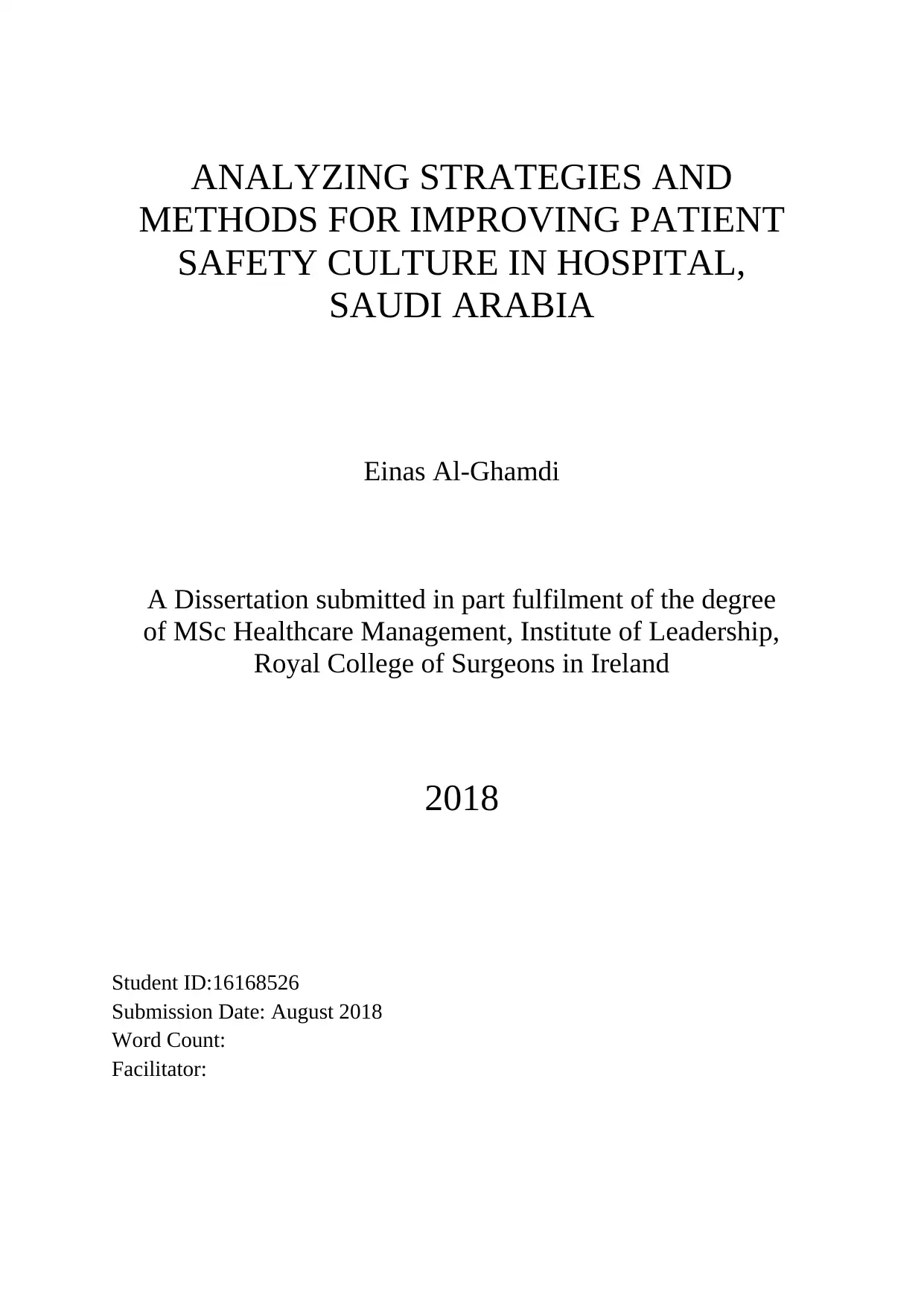
ANALYZING STRATEGIES AND
METHODS FOR IMPROVING PATIENT
SAFETY CULTURE IN HOSPITAL,
SAUDI ARABIA
Einas Al-Ghamdi
A Dissertation submitted in part fulfilment of the degree
of MSc Healthcare Management, Institute of Leadership,
Royal College of Surgeons in Ireland
2018
Student ID:16168526
Submission Date: August 2018
Word Count:
Facilitator:
METHODS FOR IMPROVING PATIENT
SAFETY CULTURE IN HOSPITAL,
SAUDI ARABIA
Einas Al-Ghamdi
A Dissertation submitted in part fulfilment of the degree
of MSc Healthcare Management, Institute of Leadership,
Royal College of Surgeons in Ireland
2018
Student ID:16168526
Submission Date: August 2018
Word Count:
Facilitator:
Paraphrase This Document
Need a fresh take? Get an instant paraphrase of this document with our AI Paraphraser
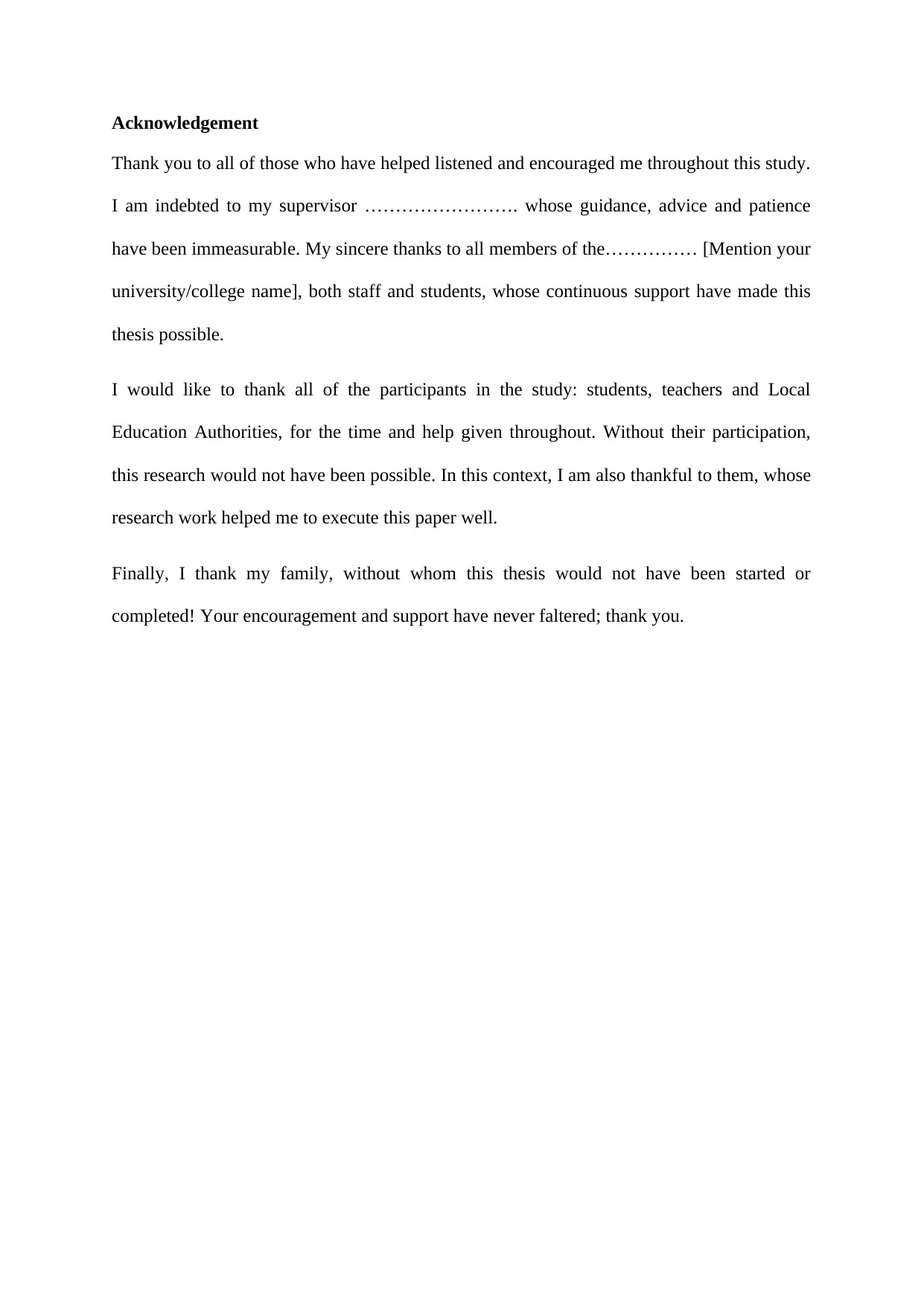
Acknowledgement
Thank you to all of those who have helped listened and encouraged me throughout this study.
I am indebted to my supervisor ……………………. whose guidance, advice and patience
have been immeasurable. My sincere thanks to all members of the…………… [Mention your
university/college name], both staff and students, whose continuous support have made this
thesis possible.
I would like to thank all of the participants in the study: students, teachers and Local
Education Authorities, for the time and help given throughout. Without their participation,
this research would not have been possible. In this context, I am also thankful to them, whose
research work helped me to execute this paper well.
Finally, I thank my family, without whom this thesis would not have been started or
completed! Your encouragement and support have never faltered; thank you.
Thank you to all of those who have helped listened and encouraged me throughout this study.
I am indebted to my supervisor ……………………. whose guidance, advice and patience
have been immeasurable. My sincere thanks to all members of the…………… [Mention your
university/college name], both staff and students, whose continuous support have made this
thesis possible.
I would like to thank all of the participants in the study: students, teachers and Local
Education Authorities, for the time and help given throughout. Without their participation,
this research would not have been possible. In this context, I am also thankful to them, whose
research work helped me to execute this paper well.
Finally, I thank my family, without whom this thesis would not have been started or
completed! Your encouragement and support have never faltered; thank you.
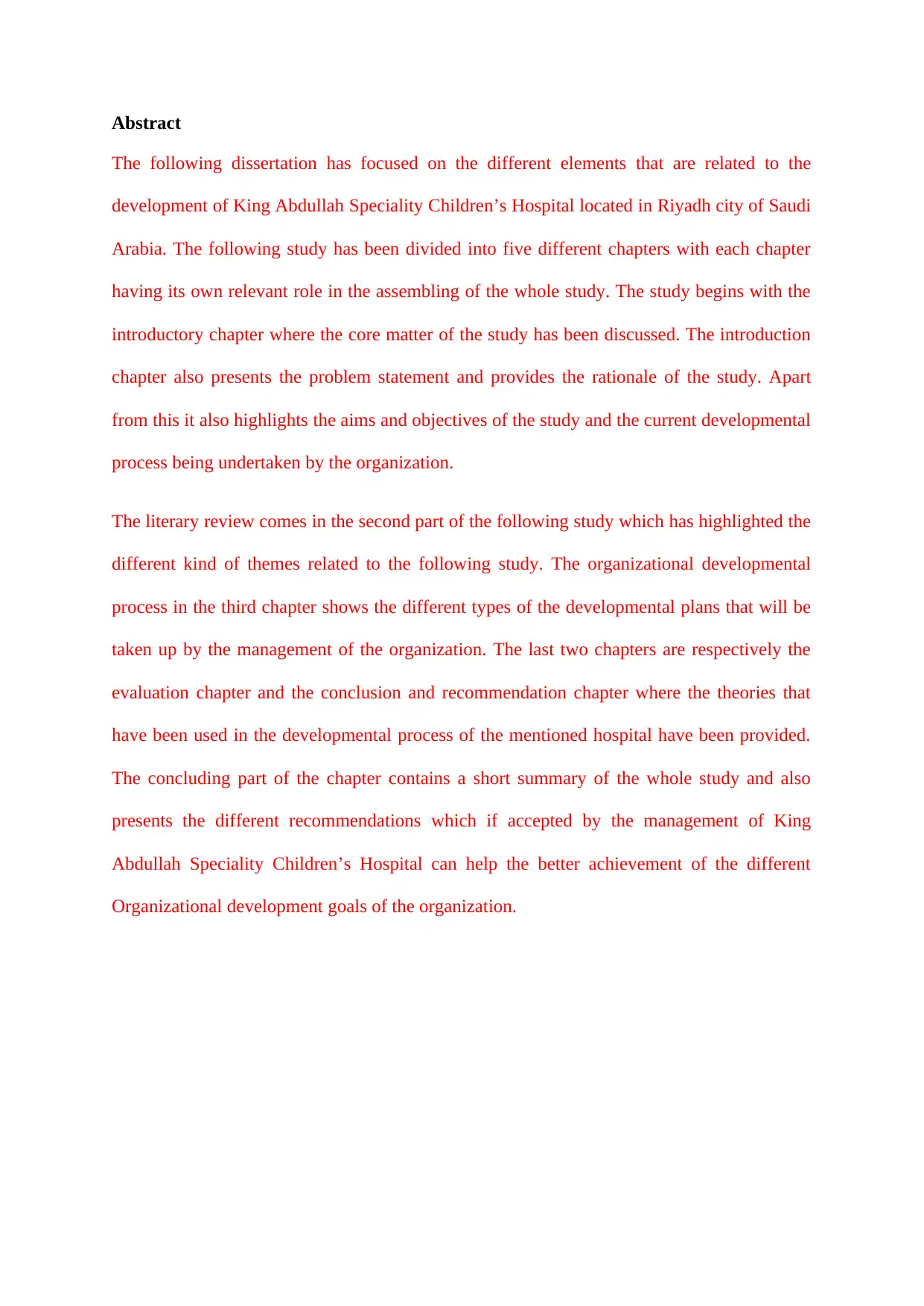
Abstract
The following dissertation has focused on the different elements that are related to the
development of King Abdullah Speciality Children’s Hospital located in Riyadh city of Saudi
Arabia. The following study has been divided into five different chapters with each chapter
having its own relevant role in the assembling of the whole study. The study begins with the
introductory chapter where the core matter of the study has been discussed. The introduction
chapter also presents the problem statement and provides the rationale of the study. Apart
from this it also highlights the aims and objectives of the study and the current developmental
process being undertaken by the organization.
The literary review comes in the second part of the following study which has highlighted the
different kind of themes related to the following study. The organizational developmental
process in the third chapter shows the different types of the developmental plans that will be
taken up by the management of the organization. The last two chapters are respectively the
evaluation chapter and the conclusion and recommendation chapter where the theories that
have been used in the developmental process of the mentioned hospital have been provided.
The concluding part of the chapter contains a short summary of the whole study and also
presents the different recommendations which if accepted by the management of King
Abdullah Speciality Children’s Hospital can help the better achievement of the different
Organizational development goals of the organization.
The following dissertation has focused on the different elements that are related to the
development of King Abdullah Speciality Children’s Hospital located in Riyadh city of Saudi
Arabia. The following study has been divided into five different chapters with each chapter
having its own relevant role in the assembling of the whole study. The study begins with the
introductory chapter where the core matter of the study has been discussed. The introduction
chapter also presents the problem statement and provides the rationale of the study. Apart
from this it also highlights the aims and objectives of the study and the current developmental
process being undertaken by the organization.
The literary review comes in the second part of the following study which has highlighted the
different kind of themes related to the following study. The organizational developmental
process in the third chapter shows the different types of the developmental plans that will be
taken up by the management of the organization. The last two chapters are respectively the
evaluation chapter and the conclusion and recommendation chapter where the theories that
have been used in the developmental process of the mentioned hospital have been provided.
The concluding part of the chapter contains a short summary of the whole study and also
presents the different recommendations which if accepted by the management of King
Abdullah Speciality Children’s Hospital can help the better achievement of the different
Organizational development goals of the organization.
⊘ This is a preview!⊘
Do you want full access?
Subscribe today to unlock all pages.

Trusted by 1+ million students worldwide
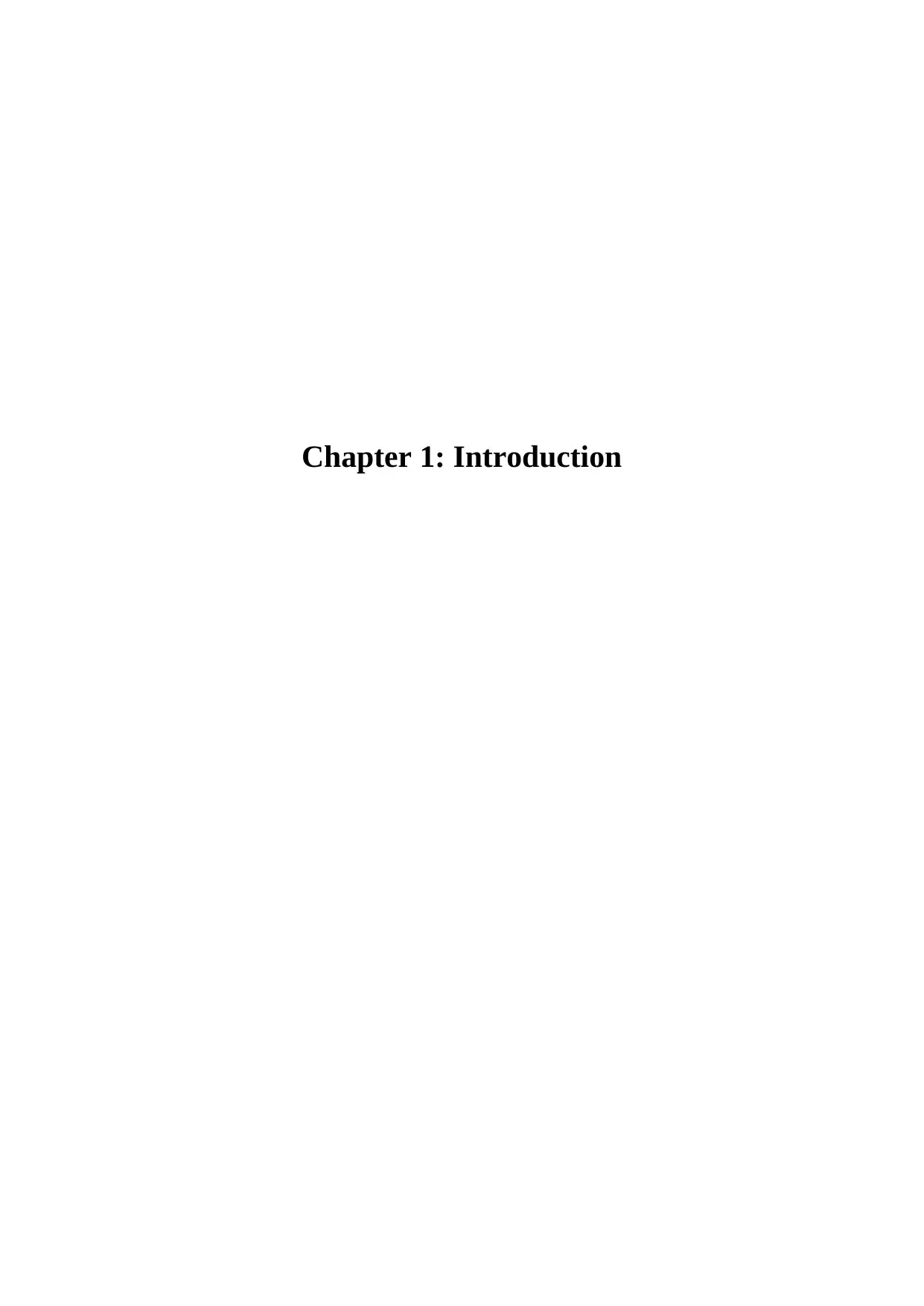
Chapter 1: Introduction
Paraphrase This Document
Need a fresh take? Get an instant paraphrase of this document with our AI Paraphraser
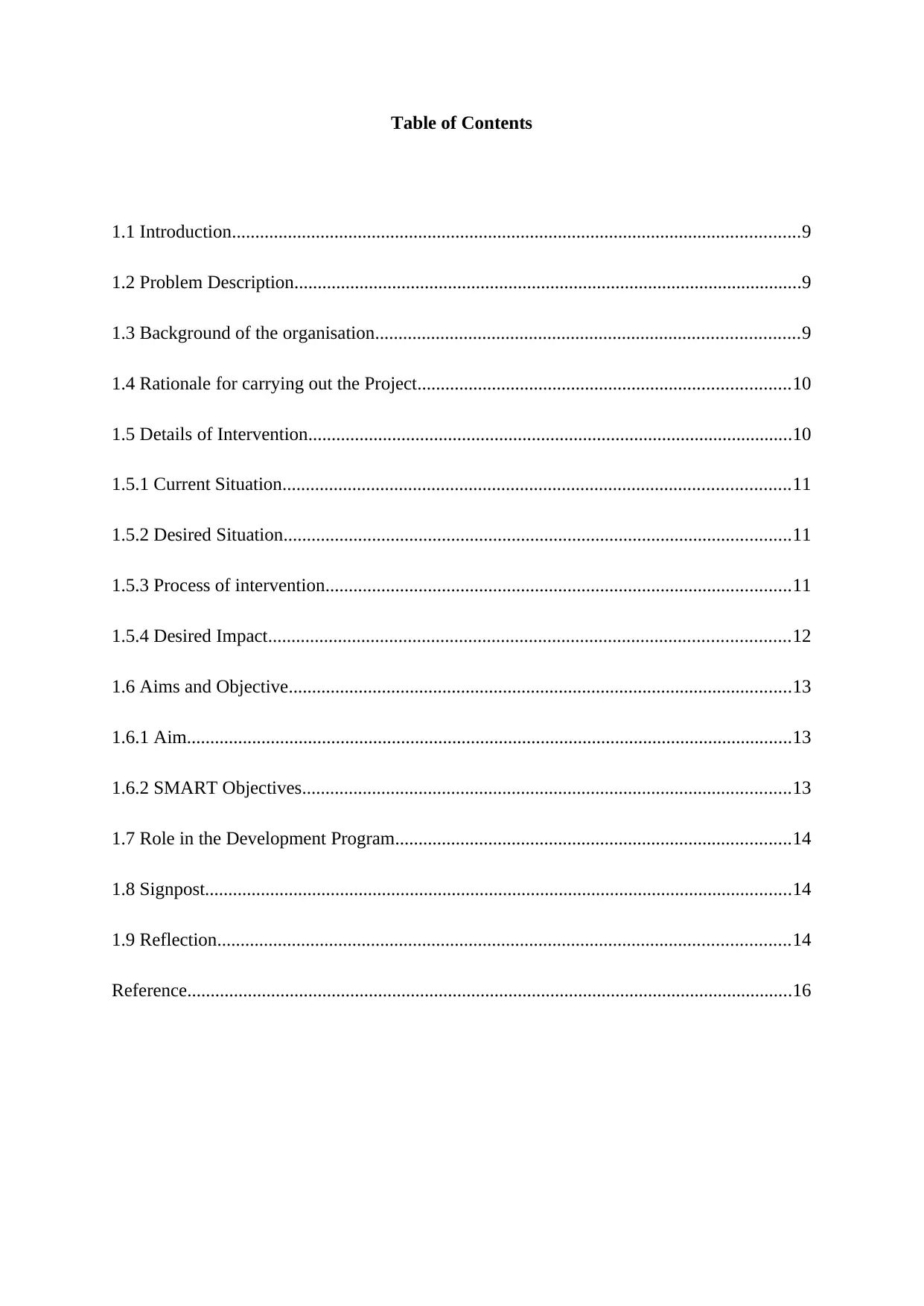
Table of Contents
1.1 Introduction..........................................................................................................................9
1.2 Problem Description.............................................................................................................9
1.3 Background of the organisation...........................................................................................9
1.4 Rationale for carrying out the Project................................................................................10
1.5 Details of Intervention........................................................................................................10
1.5.1 Current Situation.............................................................................................................11
1.5.2 Desired Situation.............................................................................................................11
1.5.3 Process of intervention....................................................................................................11
1.5.4 Desired Impact................................................................................................................12
1.6 Aims and Objective............................................................................................................13
1.6.1 Aim..................................................................................................................................13
1.6.2 SMART Objectives.........................................................................................................13
1.7 Role in the Development Program.....................................................................................14
1.8 Signpost..............................................................................................................................14
1.9 Reflection...........................................................................................................................14
Reference..................................................................................................................................16
1.1 Introduction..........................................................................................................................9
1.2 Problem Description.............................................................................................................9
1.3 Background of the organisation...........................................................................................9
1.4 Rationale for carrying out the Project................................................................................10
1.5 Details of Intervention........................................................................................................10
1.5.1 Current Situation.............................................................................................................11
1.5.2 Desired Situation.............................................................................................................11
1.5.3 Process of intervention....................................................................................................11
1.5.4 Desired Impact................................................................................................................12
1.6 Aims and Objective............................................................................................................13
1.6.1 Aim..................................................................................................................................13
1.6.2 SMART Objectives.........................................................................................................13
1.7 Role in the Development Program.....................................................................................14
1.8 Signpost..............................................................................................................................14
1.9 Reflection...........................................................................................................................14
Reference..................................................................................................................................16

⊘ This is a preview!⊘
Do you want full access?
Subscribe today to unlock all pages.

Trusted by 1+ million students worldwide
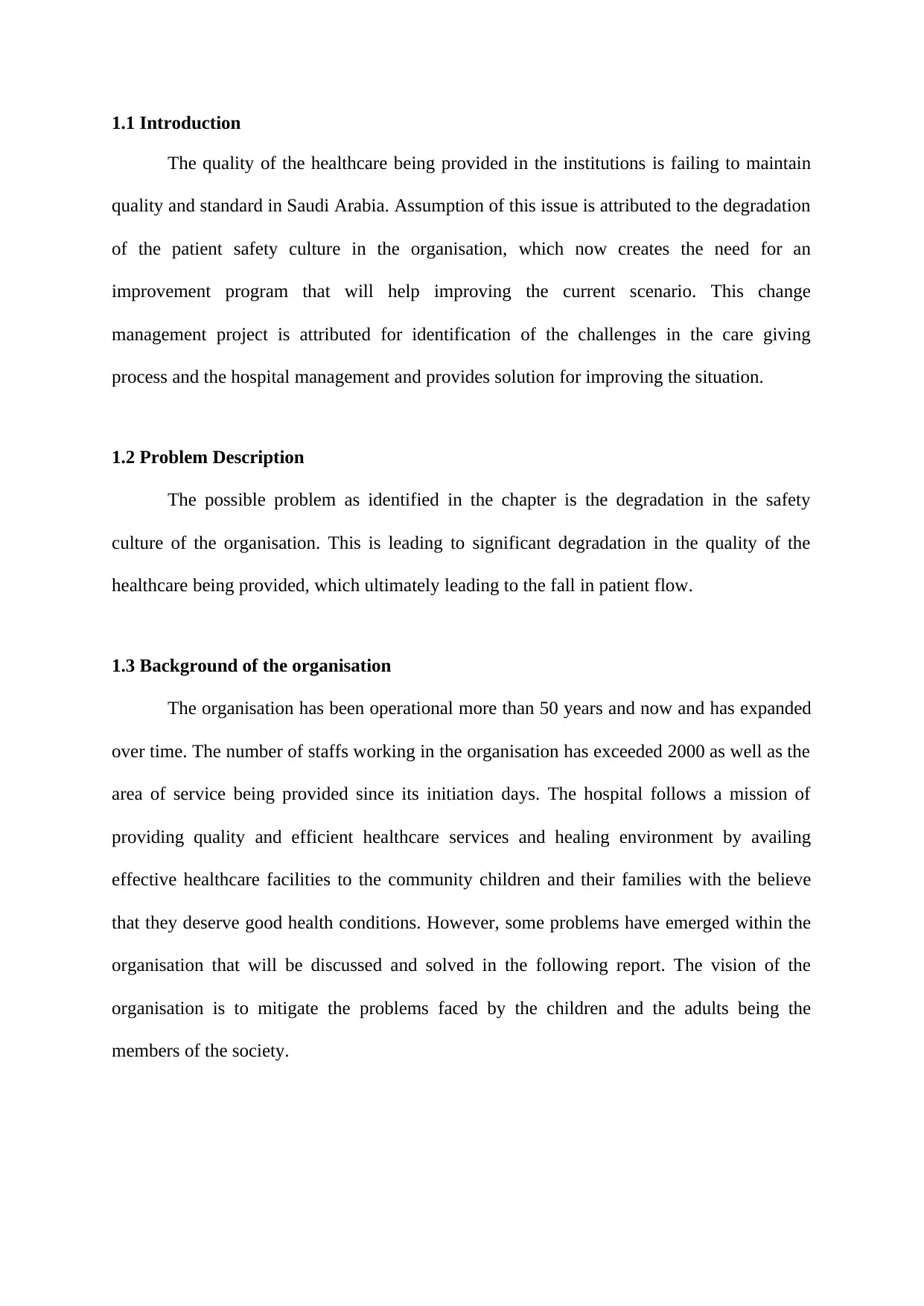
1.1 Introduction
The quality of the healthcare being provided in the institutions is failing to maintain
quality and standard in Saudi Arabia. Assumption of this issue is attributed to the degradation
of the patient safety culture in the organisation, which now creates the need for an
improvement program that will help improving the current scenario. This change
management project is attributed for identification of the challenges in the care giving
process and the hospital management and provides solution for improving the situation.
1.2 Problem Description
The possible problem as identified in the chapter is the degradation in the safety
culture of the organisation. This is leading to significant degradation in the quality of the
healthcare being provided, which ultimately leading to the fall in patient flow.
1.3 Background of the organisation
The organisation has been operational more than 50 years and now and has expanded
over time. The number of staffs working in the organisation has exceeded 2000 as well as the
area of service being provided since its initiation days. The hospital follows a mission of
providing quality and efficient healthcare services and healing environment by availing
effective healthcare facilities to the community children and their families with the believe
that they deserve good health conditions. However, some problems have emerged within the
organisation that will be discussed and solved in the following report. The vision of the
organisation is to mitigate the problems faced by the children and the adults being the
members of the society.
The quality of the healthcare being provided in the institutions is failing to maintain
quality and standard in Saudi Arabia. Assumption of this issue is attributed to the degradation
of the patient safety culture in the organisation, which now creates the need for an
improvement program that will help improving the current scenario. This change
management project is attributed for identification of the challenges in the care giving
process and the hospital management and provides solution for improving the situation.
1.2 Problem Description
The possible problem as identified in the chapter is the degradation in the safety
culture of the organisation. This is leading to significant degradation in the quality of the
healthcare being provided, which ultimately leading to the fall in patient flow.
1.3 Background of the organisation
The organisation has been operational more than 50 years and now and has expanded
over time. The number of staffs working in the organisation has exceeded 2000 as well as the
area of service being provided since its initiation days. The hospital follows a mission of
providing quality and efficient healthcare services and healing environment by availing
effective healthcare facilities to the community children and their families with the believe
that they deserve good health conditions. However, some problems have emerged within the
organisation that will be discussed and solved in the following report. The vision of the
organisation is to mitigate the problems faced by the children and the adults being the
members of the society.
Paraphrase This Document
Need a fresh take? Get an instant paraphrase of this document with our AI Paraphraser
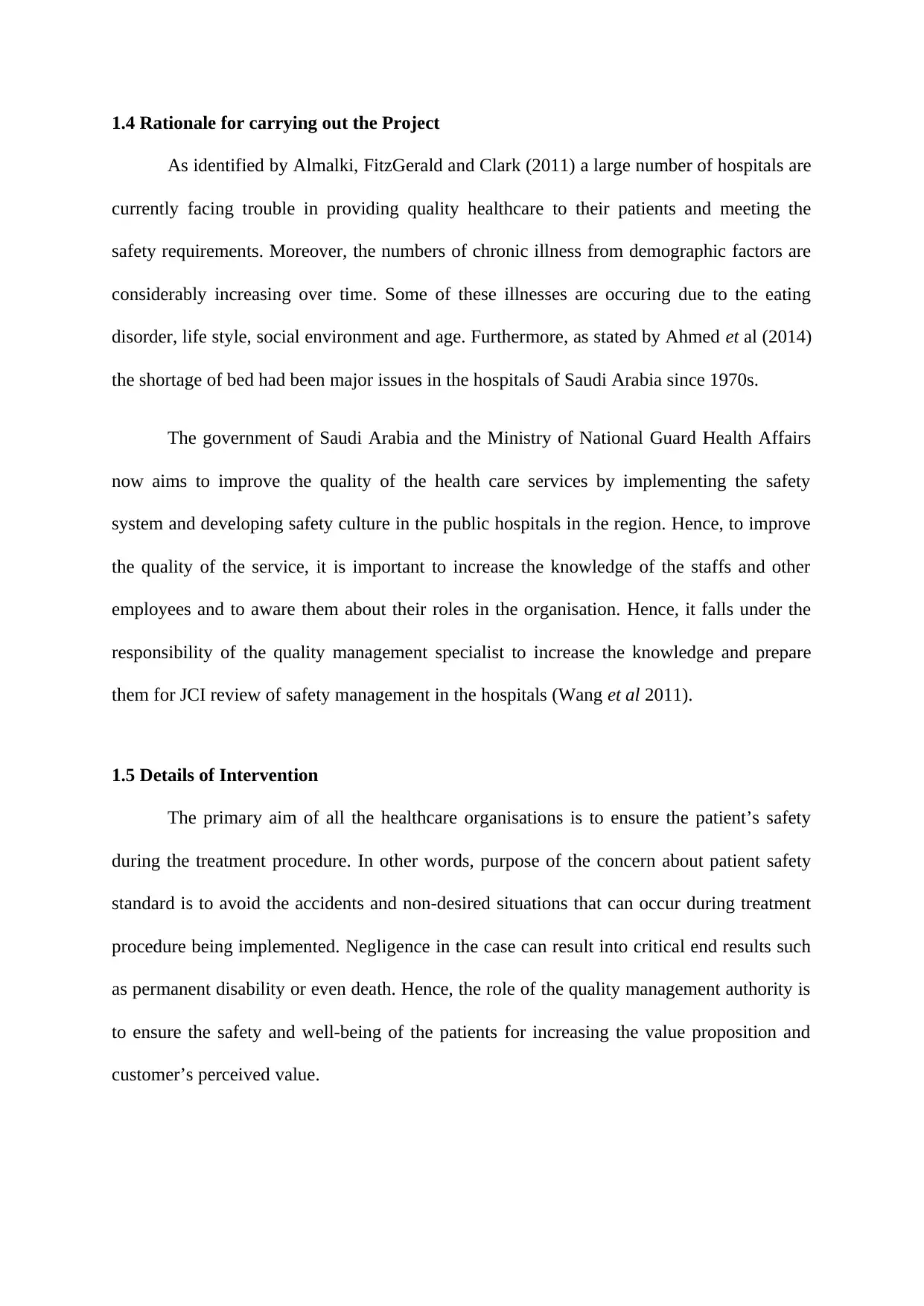
1.4 Rationale for carrying out the Project
As identified by Almalki, FitzGerald and Clark (2011) a large number of hospitals are
currently facing trouble in providing quality healthcare to their patients and meeting the
safety requirements. Moreover, the numbers of chronic illness from demographic factors are
considerably increasing over time. Some of these illnesses are occuring due to the eating
disorder, life style, social environment and age. Furthermore, as stated by Ahmed et al (2014)
the shortage of bed had been major issues in the hospitals of Saudi Arabia since 1970s.
The government of Saudi Arabia and the Ministry of National Guard Health Affairs
now aims to improve the quality of the health care services by implementing the safety
system and developing safety culture in the public hospitals in the region. Hence, to improve
the quality of the service, it is important to increase the knowledge of the staffs and other
employees and to aware them about their roles in the organisation. Hence, it falls under the
responsibility of the quality management specialist to increase the knowledge and prepare
them for JCI review of safety management in the hospitals (Wang et al 2011).
1.5 Details of Intervention
The primary aim of all the healthcare organisations is to ensure the patient’s safety
during the treatment procedure. In other words, purpose of the concern about patient safety
standard is to avoid the accidents and non-desired situations that can occur during treatment
procedure being implemented. Negligence in the case can result into critical end results such
as permanent disability or even death. Hence, the role of the quality management authority is
to ensure the safety and well-being of the patients for increasing the value proposition and
customer’s perceived value.
As identified by Almalki, FitzGerald and Clark (2011) a large number of hospitals are
currently facing trouble in providing quality healthcare to their patients and meeting the
safety requirements. Moreover, the numbers of chronic illness from demographic factors are
considerably increasing over time. Some of these illnesses are occuring due to the eating
disorder, life style, social environment and age. Furthermore, as stated by Ahmed et al (2014)
the shortage of bed had been major issues in the hospitals of Saudi Arabia since 1970s.
The government of Saudi Arabia and the Ministry of National Guard Health Affairs
now aims to improve the quality of the health care services by implementing the safety
system and developing safety culture in the public hospitals in the region. Hence, to improve
the quality of the service, it is important to increase the knowledge of the staffs and other
employees and to aware them about their roles in the organisation. Hence, it falls under the
responsibility of the quality management specialist to increase the knowledge and prepare
them for JCI review of safety management in the hospitals (Wang et al 2011).
1.5 Details of Intervention
The primary aim of all the healthcare organisations is to ensure the patient’s safety
during the treatment procedure. In other words, purpose of the concern about patient safety
standard is to avoid the accidents and non-desired situations that can occur during treatment
procedure being implemented. Negligence in the case can result into critical end results such
as permanent disability or even death. Hence, the role of the quality management authority is
to ensure the safety and well-being of the patients for increasing the value proposition and
customer’s perceived value.
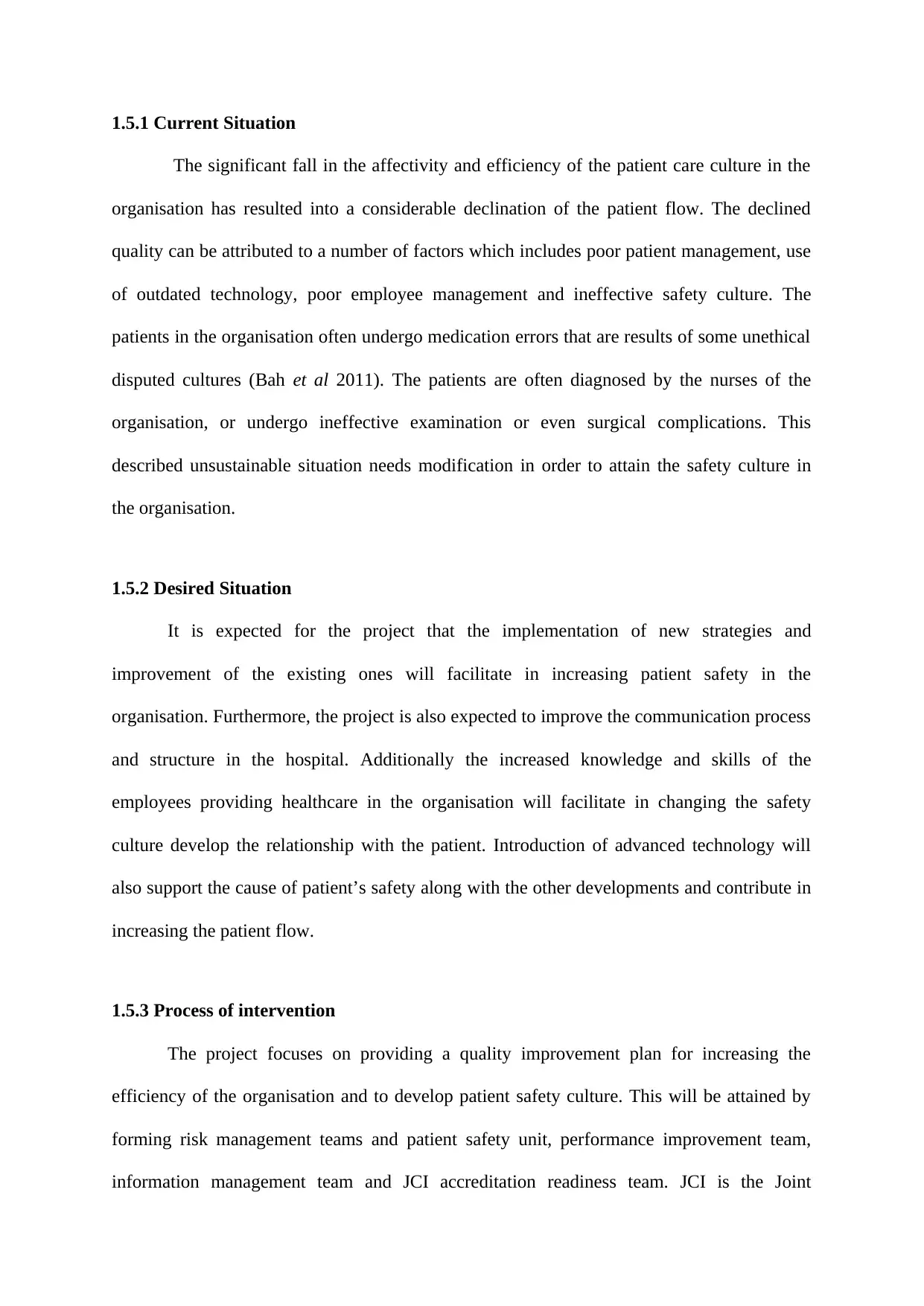
1.5.1 Current Situation
The significant fall in the affectivity and efficiency of the patient care culture in the
organisation has resulted into a considerable declination of the patient flow. The declined
quality can be attributed to a number of factors which includes poor patient management, use
of outdated technology, poor employee management and ineffective safety culture. The
patients in the organisation often undergo medication errors that are results of some unethical
disputed cultures (Bah et al 2011). The patients are often diagnosed by the nurses of the
organisation, or undergo ineffective examination or even surgical complications. This
described unsustainable situation needs modification in order to attain the safety culture in
the organisation.
1.5.2 Desired Situation
It is expected for the project that the implementation of new strategies and
improvement of the existing ones will facilitate in increasing patient safety in the
organisation. Furthermore, the project is also expected to improve the communication process
and structure in the hospital. Additionally the increased knowledge and skills of the
employees providing healthcare in the organisation will facilitate in changing the safety
culture develop the relationship with the patient. Introduction of advanced technology will
also support the cause of patient’s safety along with the other developments and contribute in
increasing the patient flow.
1.5.3 Process of intervention
The project focuses on providing a quality improvement plan for increasing the
efficiency of the organisation and to develop patient safety culture. This will be attained by
forming risk management teams and patient safety unit, performance improvement team,
information management team and JCI accreditation readiness team. JCI is the Joint
The significant fall in the affectivity and efficiency of the patient care culture in the
organisation has resulted into a considerable declination of the patient flow. The declined
quality can be attributed to a number of factors which includes poor patient management, use
of outdated technology, poor employee management and ineffective safety culture. The
patients in the organisation often undergo medication errors that are results of some unethical
disputed cultures (Bah et al 2011). The patients are often diagnosed by the nurses of the
organisation, or undergo ineffective examination or even surgical complications. This
described unsustainable situation needs modification in order to attain the safety culture in
the organisation.
1.5.2 Desired Situation
It is expected for the project that the implementation of new strategies and
improvement of the existing ones will facilitate in increasing patient safety in the
organisation. Furthermore, the project is also expected to improve the communication process
and structure in the hospital. Additionally the increased knowledge and skills of the
employees providing healthcare in the organisation will facilitate in changing the safety
culture develop the relationship with the patient. Introduction of advanced technology will
also support the cause of patient’s safety along with the other developments and contribute in
increasing the patient flow.
1.5.3 Process of intervention
The project focuses on providing a quality improvement plan for increasing the
efficiency of the organisation and to develop patient safety culture. This will be attained by
forming risk management teams and patient safety unit, performance improvement team,
information management team and JCI accreditation readiness team. JCI is the Joint
⊘ This is a preview!⊘
Do you want full access?
Subscribe today to unlock all pages.

Trusted by 1+ million students worldwide
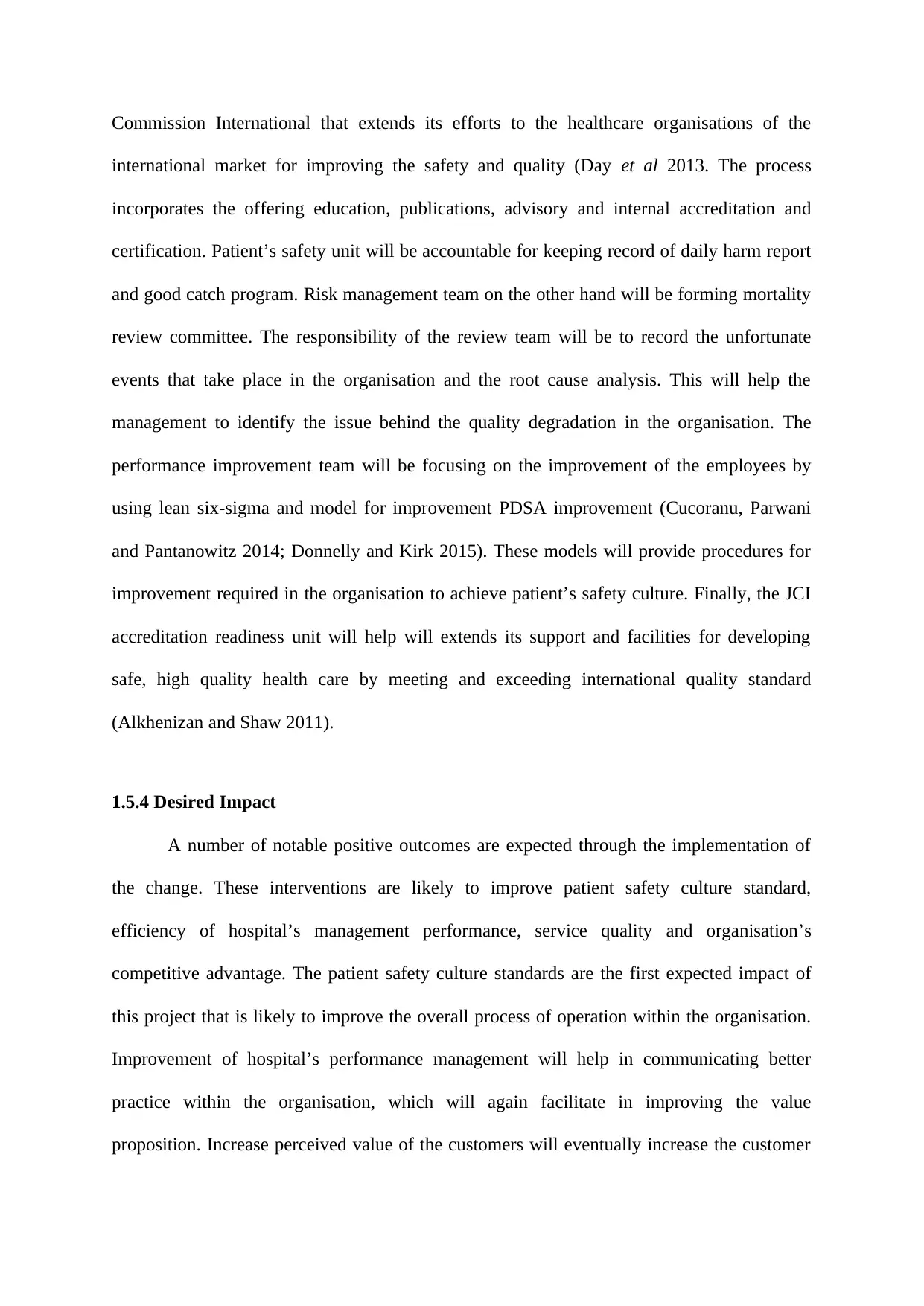
Commission International that extends its efforts to the healthcare organisations of the
international market for improving the safety and quality (Day et al 2013. The process
incorporates the offering education, publications, advisory and internal accreditation and
certification. Patient’s safety unit will be accountable for keeping record of daily harm report
and good catch program. Risk management team on the other hand will be forming mortality
review committee. The responsibility of the review team will be to record the unfortunate
events that take place in the organisation and the root cause analysis. This will help the
management to identify the issue behind the quality degradation in the organisation. The
performance improvement team will be focusing on the improvement of the employees by
using lean six-sigma and model for improvement PDSA improvement (Cucoranu, Parwani
and Pantanowitz 2014; Donnelly and Kirk 2015). These models will provide procedures for
improvement required in the organisation to achieve patient’s safety culture. Finally, the JCI
accreditation readiness unit will help will extends its support and facilities for developing
safe, high quality health care by meeting and exceeding international quality standard
(Alkhenizan and Shaw 2011).
1.5.4 Desired Impact
A number of notable positive outcomes are expected through the implementation of
the change. These interventions are likely to improve patient safety culture standard,
efficiency of hospital’s management performance, service quality and organisation’s
competitive advantage. The patient safety culture standards are the first expected impact of
this project that is likely to improve the overall process of operation within the organisation.
Improvement of hospital’s performance management will help in communicating better
practice within the organisation, which will again facilitate in improving the value
proposition. Increase perceived value of the customers will eventually increase the customer
international market for improving the safety and quality (Day et al 2013. The process
incorporates the offering education, publications, advisory and internal accreditation and
certification. Patient’s safety unit will be accountable for keeping record of daily harm report
and good catch program. Risk management team on the other hand will be forming mortality
review committee. The responsibility of the review team will be to record the unfortunate
events that take place in the organisation and the root cause analysis. This will help the
management to identify the issue behind the quality degradation in the organisation. The
performance improvement team will be focusing on the improvement of the employees by
using lean six-sigma and model for improvement PDSA improvement (Cucoranu, Parwani
and Pantanowitz 2014; Donnelly and Kirk 2015). These models will provide procedures for
improvement required in the organisation to achieve patient’s safety culture. Finally, the JCI
accreditation readiness unit will help will extends its support and facilities for developing
safe, high quality health care by meeting and exceeding international quality standard
(Alkhenizan and Shaw 2011).
1.5.4 Desired Impact
A number of notable positive outcomes are expected through the implementation of
the change. These interventions are likely to improve patient safety culture standard,
efficiency of hospital’s management performance, service quality and organisation’s
competitive advantage. The patient safety culture standards are the first expected impact of
this project that is likely to improve the overall process of operation within the organisation.
Improvement of hospital’s performance management will help in communicating better
practice within the organisation, which will again facilitate in improving the value
proposition. Increase perceived value of the customers will eventually increase the customer
Paraphrase This Document
Need a fresh take? Get an instant paraphrase of this document with our AI Paraphraser
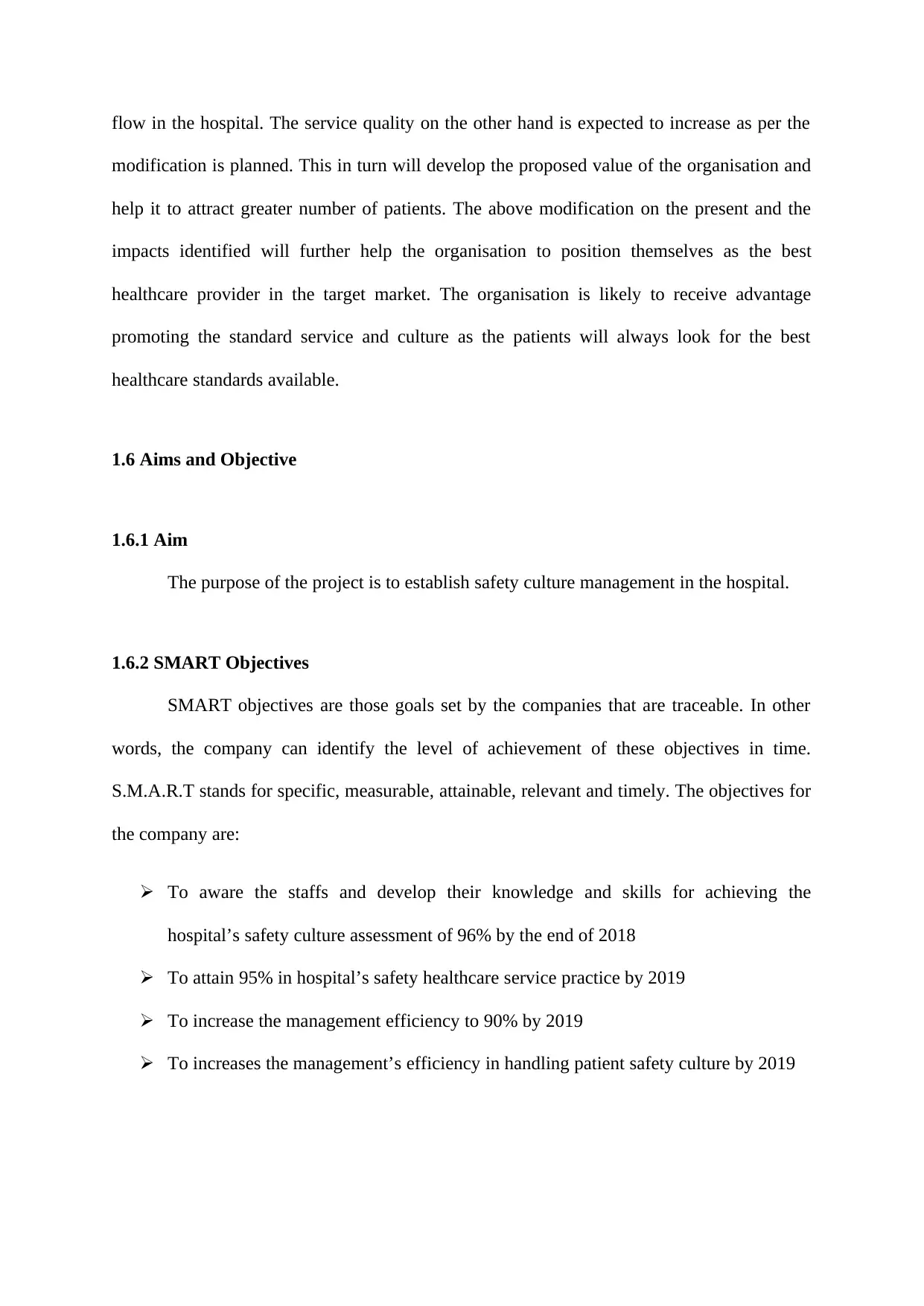
flow in the hospital. The service quality on the other hand is expected to increase as per the
modification is planned. This in turn will develop the proposed value of the organisation and
help it to attract greater number of patients. The above modification on the present and the
impacts identified will further help the organisation to position themselves as the best
healthcare provider in the target market. The organisation is likely to receive advantage
promoting the standard service and culture as the patients will always look for the best
healthcare standards available.
1.6 Aims and Objective
1.6.1 Aim
The purpose of the project is to establish safety culture management in the hospital.
1.6.2 SMART Objectives
SMART objectives are those goals set by the companies that are traceable. In other
words, the company can identify the level of achievement of these objectives in time.
S.M.A.R.T stands for specific, measurable, attainable, relevant and timely. The objectives for
the company are:
To aware the staffs and develop their knowledge and skills for achieving the
hospital’s safety culture assessment of 96% by the end of 2018
To attain 95% in hospital’s safety healthcare service practice by 2019
To increase the management efficiency to 90% by 2019
To increases the management’s efficiency in handling patient safety culture by 2019
modification is planned. This in turn will develop the proposed value of the organisation and
help it to attract greater number of patients. The above modification on the present and the
impacts identified will further help the organisation to position themselves as the best
healthcare provider in the target market. The organisation is likely to receive advantage
promoting the standard service and culture as the patients will always look for the best
healthcare standards available.
1.6 Aims and Objective
1.6.1 Aim
The purpose of the project is to establish safety culture management in the hospital.
1.6.2 SMART Objectives
SMART objectives are those goals set by the companies that are traceable. In other
words, the company can identify the level of achievement of these objectives in time.
S.M.A.R.T stands for specific, measurable, attainable, relevant and timely. The objectives for
the company are:
To aware the staffs and develop their knowledge and skills for achieving the
hospital’s safety culture assessment of 96% by the end of 2018
To attain 95% in hospital’s safety healthcare service practice by 2019
To increase the management efficiency to 90% by 2019
To increases the management’s efficiency in handling patient safety culture by 2019
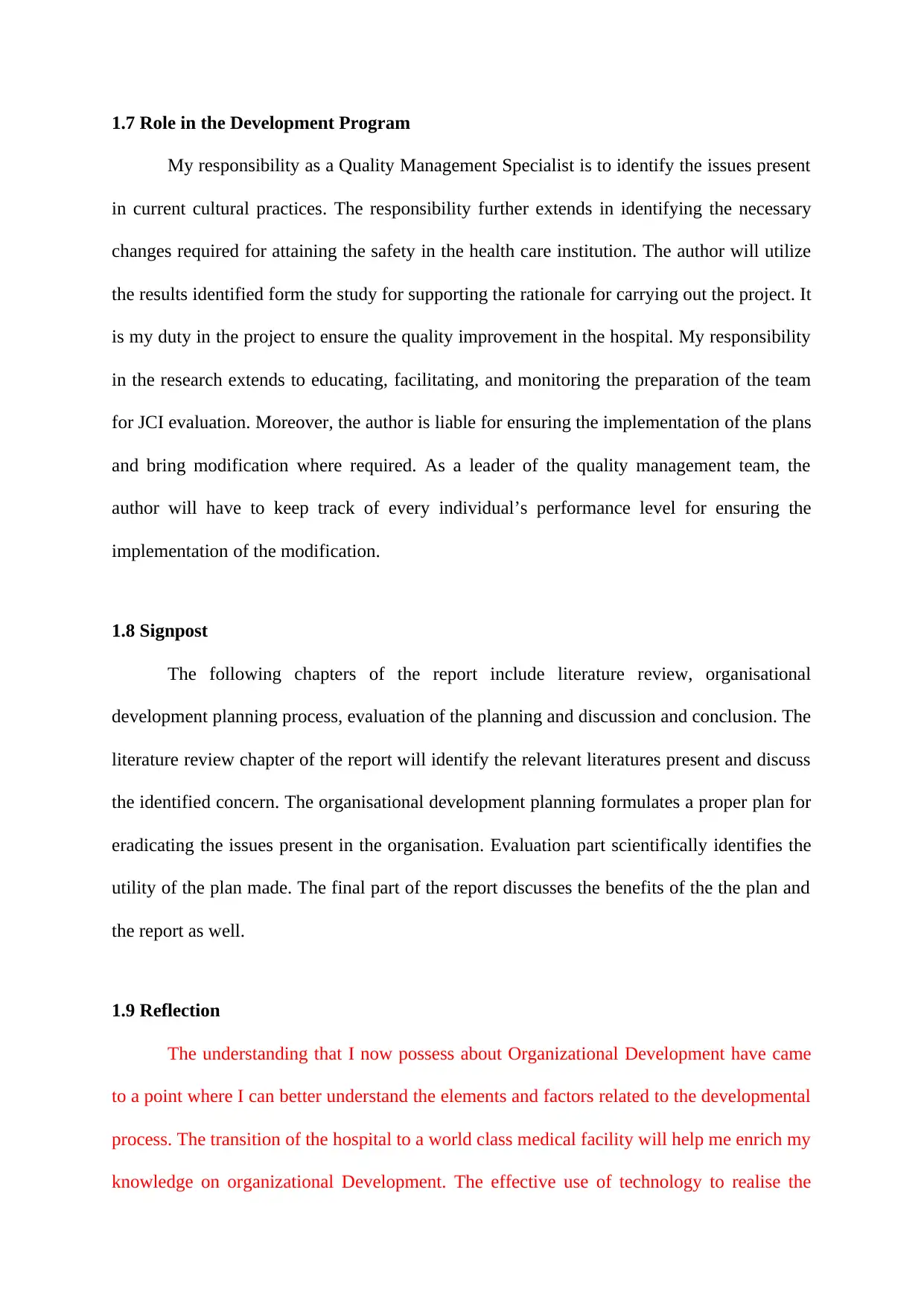
1.7 Role in the Development Program
My responsibility as a Quality Management Specialist is to identify the issues present
in current cultural practices. The responsibility further extends in identifying the necessary
changes required for attaining the safety in the health care institution. The author will utilize
the results identified form the study for supporting the rationale for carrying out the project. It
is my duty in the project to ensure the quality improvement in the hospital. My responsibility
in the research extends to educating, facilitating, and monitoring the preparation of the team
for JCI evaluation. Moreover, the author is liable for ensuring the implementation of the plans
and bring modification where required. As a leader of the quality management team, the
author will have to keep track of every individual’s performance level for ensuring the
implementation of the modification.
1.8 Signpost
The following chapters of the report include literature review, organisational
development planning process, evaluation of the planning and discussion and conclusion. The
literature review chapter of the report will identify the relevant literatures present and discuss
the identified concern. The organisational development planning formulates a proper plan for
eradicating the issues present in the organisation. Evaluation part scientifically identifies the
utility of the plan made. The final part of the report discusses the benefits of the the plan and
the report as well.
1.9 Reflection
The understanding that I now possess about Organizational Development have came
to a point where I can better understand the elements and factors related to the developmental
process. The transition of the hospital to a world class medical facility will help me enrich my
knowledge on organizational Development. The effective use of technology to realise the
My responsibility as a Quality Management Specialist is to identify the issues present
in current cultural practices. The responsibility further extends in identifying the necessary
changes required for attaining the safety in the health care institution. The author will utilize
the results identified form the study for supporting the rationale for carrying out the project. It
is my duty in the project to ensure the quality improvement in the hospital. My responsibility
in the research extends to educating, facilitating, and monitoring the preparation of the team
for JCI evaluation. Moreover, the author is liable for ensuring the implementation of the plans
and bring modification where required. As a leader of the quality management team, the
author will have to keep track of every individual’s performance level for ensuring the
implementation of the modification.
1.8 Signpost
The following chapters of the report include literature review, organisational
development planning process, evaluation of the planning and discussion and conclusion. The
literature review chapter of the report will identify the relevant literatures present and discuss
the identified concern. The organisational development planning formulates a proper plan for
eradicating the issues present in the organisation. Evaluation part scientifically identifies the
utility of the plan made. The final part of the report discusses the benefits of the the plan and
the report as well.
1.9 Reflection
The understanding that I now possess about Organizational Development have came
to a point where I can better understand the elements and factors related to the developmental
process. The transition of the hospital to a world class medical facility will help me enrich my
knowledge on organizational Development. The effective use of technology to realise the
⊘ This is a preview!⊘
Do you want full access?
Subscribe today to unlock all pages.

Trusted by 1+ million students worldwide
1 out of 97
Related Documents
Your All-in-One AI-Powered Toolkit for Academic Success.
+13062052269
info@desklib.com
Available 24*7 on WhatsApp / Email
![[object Object]](/_next/static/media/star-bottom.7253800d.svg)
Unlock your academic potential
Copyright © 2020–2025 A2Z Services. All Rights Reserved. Developed and managed by ZUCOL.





